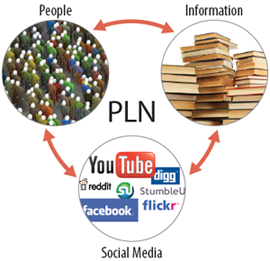283
Building a Personal Learning Network

A personal learning network (PLN) is a community of people who connect with each other to share knowledge, ideas, and resources. Social media offer an extraordinary environment for personal learning, allowing you to tap into a broad scope of people and knowledge. Cultivating a PLN helps you accomplish the following tasks:
- Seeking and storing information about topics that are important to you
- Fostering connections with people from across the globe
- Interacting with experts in various fields
- Gaining feedback and inspiration from others’ work
- Sharing your knowledge with others
- Collaborating with others to answer questions and complete projects
Using Social Media to Create a PLN
Use social networks (Twitter, Facebook, Google+, LinkedIn) to follow the people and organizations that share your common interests, even if you don’t know them personally. Create separate PLNs for your personal and school-related interests, and follow these tips to establish strong learning networks:
Tips for Creating Strong Learning Networks
- Begin the conversation. Ask questions, make comments, and share relevant information on social networks.
- Find relevant sites. Bookmark or subscribe to blogs, Web sites, podcasts, or videos that offer content related to your interests or topic of study.
- Organize material. Use RSS feeds to syndicate your bookmarked material in one place.
- Participate. Discover and contribute to wikis or message boards related to your interests or topic of study.
- Categorize messages. Use (and search for) hashtags in microblogs that relate to your area of interest or topic of study.
- Be helpful. Offer constructive comments and questions on blogs and microblogs.
Your Turn Choose a topic, either school-related or personal, that especially interests you. Using social media, build a PLN and pursue your interest.
284
Using a PLN to Answer Project-Based
Questions
You can use social media to answer questions about school projects. The next two pages explain how a group of students built a social-media-based personal learning network (PLN) to complete a science project.
Case Study: Project Biodiesel
Background: Students working on a science project are researching alternative fuel types, specifically biodiesel, which is diesel fuel made from processed vegetable oil. They want to learn as much as they can about the fuel type, including the viability of building a biodiesel processor in their school laboratory.
Questions: How can we build a basic biodiesel processor? What parts do we need? How can we obtain the parts for a reasonable cost?
Creating a Specialized PLN
The students used social media to find answers to their project-based questions.
▶ Social Networks: By creating a Twitter account for their project, the students began following a network of people and organizations that shared an interest in biodiesel fuel. They built this network by completing the following tasks.
- Conducting a hashtag search: With the hashtag #biodiesel, students found many current Tweets about their topic.
- Following accounts: Students followed the people and organizations that shared news and information about biodiesel.
- Asking project-based questions: Students directed their questions to people who shared a common interest in biodiesel.

▶ Aggregators: In the course of their research, a few news sites and blogs emerged as the students’ favorites. Instead of checking each site daily for new content, the students saved time by subscribing to the sites’ RSS feeds. Consequently, all the new content from each site automatically filtered into their Feedly aggregator. (For more examples of aggregators, visit thoughtfullearning.com/h284.)
285
▶ Message Boards: Using a search engine, the students found a message board titled “Biodiesel & SVO Discussion Forums.” Two discussion threads on the message board caught their eye: “Making Biodiesel” and “Biodiesel Equipment.” The students introduced themselves on each thread, explained their project idea, and asked and answered questions about it.

A The discussion threads are relevant to the project.
B The large number of posts shows the thread is popular.
C The date of the latest post shows the message board is active and up-to-date.
▶ Social Bookmarking: Discovering many different resources on biodiesel, the students realized they needed a way to keep track of them all. So each one signed up for a social bookmarking tool that allowed him or her to save the resources they came across to one place, creating a personalized digital library. By bookmarking, they could (1) have continual access to the material from any computer or digital device, (2) categorize the material with keyword tags for easy searching, and (3) share their entire bookmarked collection with other members in the group. (See page 280 for examples of social bookmarking tools.)
▶ Online Video: The students searched online for other high schools engaging in biodiesel projects. One video showed a high school’s homemade biodiesel processor. The students contacted the video’s creator and were able to contact the other high school group and learn about their experience building and maintaining a biodiesel processor in their school laboratory.
PLN Summary
The students’ purpose for building a PLN was to answer pressing questions about a project. In doing so, they received a wide range of information about biodiesel processors, including how they are built and where to go for parts. In addition, students connected with others from another high school who had completed a successful biodiesel initiative in which they built a processor and donated the converted biodiesel to local farmers. The collaboration motivated the students to began creating, improving, and presenting their own biodiesel initiative.
Inquiry Timeline





